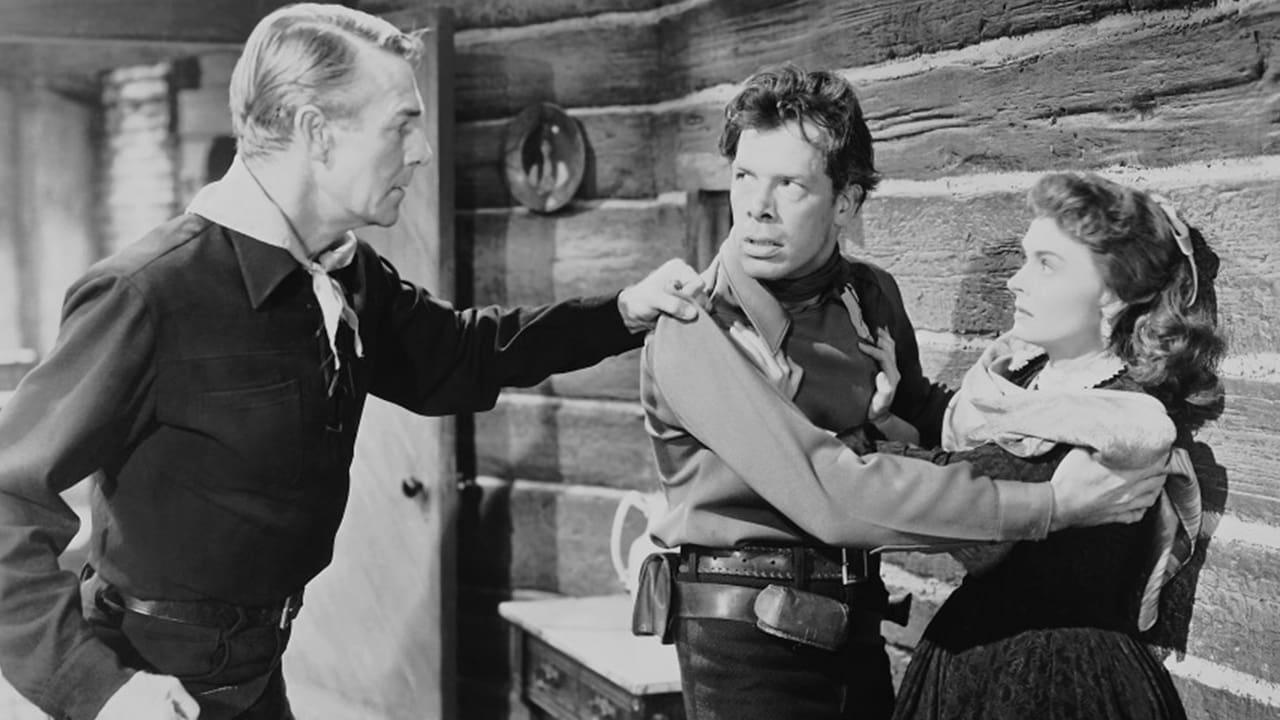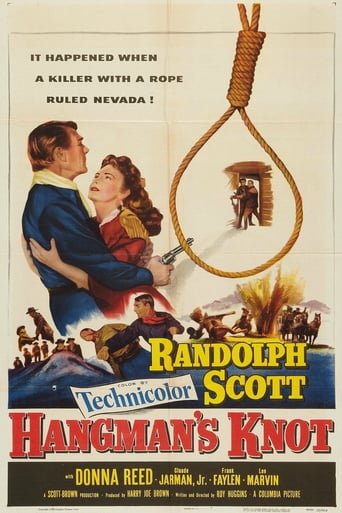



A Brilliant Conflict
Clever and entertaining enough to recommend even to members of the 1%
View MoreA lot of perfectly good film show their cards early, establish a unique premise and let the audience explore a topic at a leisurely pace, without much in terms of surprise. this film is not one of those films.
View MoreMostly, the movie is committed to the value of a good time.
View MoreThe first 20-minutes had me panting for breath. It's non-stop action as Scott and his Confederate detachment waylay a Union gold shipment, and where else, but in the scenic Alabama Hills. Between the wagons rolling and all the shooting, there's enough action for an entire movie, even a western. After that 20-minutes, however, the action goes indoors in a waystation, where a gang of drifters have Scott and Co. trapped. There's still a lot of gunplay, but the focus now is on character and how people react to being thrown together in tight quarters.All in all, it's a well-scripted western, as the gold takes on a certain amount of symbolism, becoming finally symbolic of Scott reconciling to the Civil War's end. It's a big cast of supporting players, generally well acted. But the real script triumph is inserting Jarman Jr. and Nolan as victims of the war on opposite sides. His family was killed by Sherman's march through Georgia, while her son was lost to the rebs. Jarman's youthfully innocent appearance is almost striking in contrast to all the rough-necks; at the same time, that fine actress Nolan is near mute, traumatized by her losses. That final scene between them and crusty old Clem Bevans is unusually poignant for a macho western.Of course, Scott is Scott, rock solid throughout, while Marvin delivers his wild card with the kind of brutal clarity he was so good at. My only complaint is with the gunfight staging around the waystation. It's poorly done, especially when Scott rescues buddy Faylen from the hangman's knot. Director-scripter Huggins was an excellent idea man, but I can see why he directed only this one theatre feature. Anyway, it's a character-driven oater that should please the most demanding Scott fan.(In passing—some shots of the burning roof plus the rain storm suggest the producers were considering a 3-D release. After all, 1953 was the big year for that short-lived process.)
View MoreI was kind of torn as to whether to give this movie a 6 or a 7. After all, while entertaining and well done compared to most westerns, it also suffers a bit from a claustrophobic feel as well as a lot of similarity to other films--even other Randolph Scott films. I'll give it a 7, simply because even a mediocre Scott film is better than the norm.The film starts with Scott leading a raiding party of Confederates on a Union gold shipment. The problem is that they don't realize that the war is over--and that by killing these troops and taking the gold that they might be viewed as crooks, not men serving their country. Instead of returning the gold and surrendering (which probably would have kept them from a hanging), they decide to keep the gold and make a run for it. Scott says he's keeping the gold and plans on using it to rebuild the South, but the rest of the gang isn't so strongly inclined. However, before the whole thing degenerates into an all-out brawl for the money, an outside force intervenes. Various posses are looking for them once the dead soldiers are found and one group that corners them isn't particularly interested in bringing anyone to justice--they just want to steal the gold and kill everyone to get rid of witnesses--forcing the ex-Confederates to strongly bond together--except for a problematic guy played by Lee Marvin--a very typical 1950s role for him.The film benefits from excellent acting all around and despite some very familiar story elements and clichés, is quite entertaining. HOWEVER, there is one seriously bad problem and one smaller one with the film. First, the really bad. In a fight between Marvin and Scott, you can very, very clearly see that they are stuntmen and this might just be the worst non-deliberate example I've seen (I'M GONNA GIT YOU SUCKA's is worse, but clearly meant to be as white guy with a mustache doubles for a black woman). They obviously are not Marvin or Scott--it's not even close. The other smaller problem are some story elements that, if you think about them, make no sense. Why did Scott and his men hold up the wagon? This made no sense, nor did Donna Reed suddenly falling for Scott at the end (an obvious cliché). Regardless, Scott fans will love this and non-western lovers will probably find it all tolerable at best.
View MoreHangmans Knot is only slightly better than the average western of its time. However there is one huge difference between this film & film of today.Randolph Scott was a top rated STAR of his time,he was able to carry a movie all by himself, BUT the powers that be back then always surrounded there star with major featured players who were well known at the time. In todays film, you are lucky if you even recognize any one else but the star.The supporting cast of Hangmans Knot is a who's who of players, some were well known, some just starting out & some old timers who seemed to be in many films.The cast here includes. Donna Reed,Lee Marvin,Claude Jarmen Jr, Clem Bevans, Jeanette Nolan, Frank Faylen, Richard Denning among others.The payroll was not inflated either, as nearly every one of them were on contract to the studio.Roy Huggins of TV fame both wrote & directed this film & it is quite violent for its time.Do not expect a great film, it is just a slightly better than average routine western of its time.In fact the only annoying note is the overly romantic kiss between Randolph Scott & Donna Reed at next to last scene . Back then it was required to have either or both a comic bit or a clinch.The running time is only 81 minutes BUT there is more action than in todays 2 hour films.They thankfully did not have endless song scores to stop the action..It was filmed in Technicolor in an area just north of Los Angeles that was wide open space back then. Today its all homes & shopping centers.Ratings: *** (out of 4) 82 points (out of 100) IMDb 7 (out of 10)
View MoreThis film showcases the legal problems that occur in the transformation from war to peace. This was made more difficult in the days before rapid communications over long distances. Thus, the most important battle in the War of 1812 was fought some time after the peace treaty was signed. In the present case, we also have the problem of determining exactly when the Confederacy ceased to exist. Lee's surrender of his army did not constitute an official end to the Confederacy. In fact, another army surrendered several weeks later. There was no general peace treaty. Of course, Major Stewart(Randy) only knew what a dying Union commander told him: that the Confederacy was dead. Thus, he and his follow Confederate raiders had to decide what was the likely best thing for them to do with the gold they had just stolen from a Union cavalry detachment in this Nevada wasteland. They were afraid they would be hung either as Confederate spies or as civilian thieves if they turned the gold over to local authorities. This was made much more likely by the fact that they had killed the cavalry escorting the gold shipment. Thus, they decided to keep the gold until they decided for sure to split it. The raiders returned to their base camp and piled into their stolen buggy, leaving their horses behind(why?). Later, they are met by a group of horsemen who identify themselves as a posse looking for the gold thieves. Randy tells them a story that makes them travel in the opposite direction, but he knows they will be back after they find out this is a lie. The raiders then ditch their buggy and stop a stage, which they all fit into or onto. They convert the next way station into a fortress, with the posse in hot pursuit. There are 2 hostages from the stage: ex-union army nurse Molly(Donna Reed)and her semi-fiancé, as well as the elderly station caretakers. Randy tries to convince the posse that they left the gold elsewhere , but they don't buy it. The raiders make an escape attempt that night, but only succeed in rescuing a raider captive. He tells them the men outside are no posse, rather a gang of drifters. Meanwhile, the raiders and hostages are getting to know each other better, Molly's nursing skills being put to good use. Molly gradually warms up to Randy, as we expect, after she sees how he handles various sticky situations. Ralph(Lee Marvin) is jealous and tries to shoot Randy, after they have quite a brawl, but brother Jamie shoots Ralph first.The outlaw gang now tries to tunnel under the building, then set fire to it. As burning roof beams fall, Molly's fiancé runs out, but is shot by the outlaws. Luckily, a rare severe storm then strikes, putting out the fire and providing some cover for the raiders, who exit the building and kill or confuse some of the outlaws, while other outlaws look for the gold inside. Satisfied there is no gold, the remaining outlaws ride off to look for it elsewhere(presumably somewhere near the abandoned buggy). The now 2 remaining raiders(Randy and Jamie) make peace with the remaining hostages and promise to return after a cooling off period in former Confederate territory.We're left wondering what happened to the gold, since Randy and Jamie decided to leave it with the hostages. They are characterized as honest folk, thus most likely turned it over to authorities, explaining that the thieves had all been killed in a shootout between two gangs or by themselves.This is an excellent intense western drama, quite in keeping with the later series of Scott-staring westerns directed by Boetticher. The one positive thing that came out of this fiasco was that Molly came to realize that Randy, not her handsome urbane semi-fiancé, was the right man for her, provided he did the right thing and left the gold for her and the station attendants to dispose of honorably. However, as typically, the budding romance is left in an uncertain state at ending. In additional to the interesting screenplay, the crisp Technicolor cinematography of the unique giant boulder-strewn Alabama Hills, with snow-capped High Sierras in the background, makes for a spectacular-looking physical setting.Anyone who has seen "The Yearling" will instantly recognize an older Claude Jarman, as Scott's young friend, Jamie.... Perennial 'old codger' Clem Bevans, also in "The Yearling", serves as the stage station master...Familiar-looking Ray Teal, playing the leader of the bandits, meets a fate similar to that of Bruce Dern, in "The Cowboys", although clearly a dummy was used in the dark rainy conditions....Lee Marvin plays his typical sneering bully or cynic character....Handsome Richard Denning as Donna's dandy semi-fiancé saves the situation, if not his life, by correctly predicting a violent thunderstorm will soon strike. The long rain-soaking sequence, shot in near darkness, is unique in westerns that I have seen.If you've seen "Virginia City"(1940), with Scott and Flynn costarring, you will recognize a basically similar plot.
View More